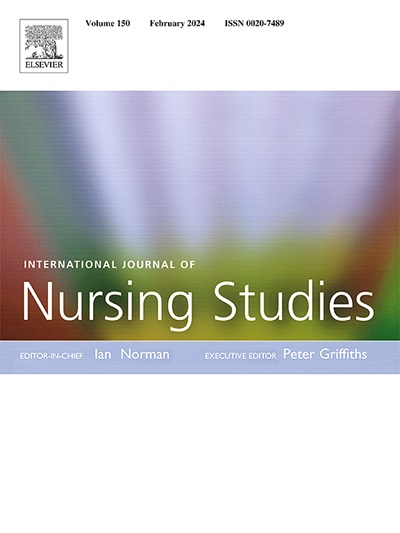Comparative effect of nonpharmacological interventions on emergence delirium prevention in children following sevoflurane general anesthesia: A systematic review and network meta-analysis of randomized controlled trials
IF 7.5
1区 医学
Q1 NURSING
引用次数: 0
Abstract
Background
Children receiving general anesthesia while undergoing surgery have a significantly high incidence of emergence delirium (ED). Nonpharmacological interventions yield beneficial effects on preventing pediatric ED. However, the relative effects of nonpharmacological interventions on pediatric ED prevention based on various perioperative phases remain unknown.
Objective
To compare the effects of nonpharmacological interventions on pediatric ED prevention at different surgical phases.
Design
A systematic review and network meta-analysis.
Data sources
A comprehensive search of five electronic databases (PubMed, CINAHL via EBSCOhost, Embase via Elsevier, Cochrane Trials, and ProQuest Dissertations and theses) for identifying randomized control trials published from inception to October 15, 2023.
Methods
Two reviewers independently screened, assessed, and extracted data from the eligible studies. A random-effects network meta-analysis was used to determine the comparative effect of nonpharmacological interventions on preventing pediatric ED.
Results
A total of 19 studies involving 2522 children were included in this network meta-analysis. Thirteen studies reported on the prevention of pediatric ED in the preoperative phase, and six studies reported on the prevention of pediatric ED in the intraoperative phases. Multimedia devices (OR 0.39, 95 % CIs 0.20–0.74), a multicomponent program (OR 0.20, 95 % CI 0.14–0.28) significantly reduced the incidence of pediatric ED during the preoperative phase compared with usual care. During the intraoperative phase, listening to regular heartbeat sounds significantly reduced the risk of pediatric ED compared with usual care (OR 0.06, 95 % CI 0.02–0.22), placebo (OR 0.11, 95 % CI 0.03–0.36), acupuncture (OR 0.17, 95 % CI 0.03–0.88), acupuncture with electrical stimulus (OR 0.16, 95 % CI 0.04–0.68), and acupuncture with midazolam (OR 0.04, 95 % CI 0.00–0.41).
Conclusions
Our study results suggest that the multicomponent program and listening to heartbeat sounds are relatively effective nonpharmacological interventions for preventing pediatric ED during the perioperative phase. This study compared the effectiveness and ranking of various interventions, and the findings can serve as a guide to assist health professionals in choosing the optimal strategy for preventing ED.
Registration
The study protocol was registered at PROSPERO (CRD42023459541).
Tweetable abstract: Nonpharmacological interventions can reduce the high incidence of pediatric emergence delirium after surgery. Our systematic review highlights the efficacy of multicomponent programs and listening to heartbeat sounds intraoperatively in reducing ED risk. The findings aid health professionals in selecting optimal strategies for pediatric perioperative care.
非药物干预对预防七氟醚全身麻醉后儿童出现性谵妄的比较效果:随机对照试验的系统回顾和网络荟萃分析
背景:手术中接受全身麻醉的儿童出现突发性谵妄(ED)的发生率非常高。非药物干预对预防儿童ED有有益的效果。然而,基于围手术期不同的非药物干预对儿童ED预防的相对效果尚不清楚。目的比较不同手术阶段非药物干预对儿童ED预防的效果。设计系统评价和网络荟萃分析。数据源全面检索5个电子数据库(PubMed,通过EBSCOhost检索的CINAHL,通过Elsevier检索的Embase, Cochrane Trials和ProQuest Dissertations and thesis),以确定从开始到2023年10月15日发表的随机对照试验。方法两名审稿人独立筛选、评估和提取符合条件的研究数据。采用随机效应网络meta分析来确定非药物干预对预防儿童ed的比较效果。结果共纳入19项研究,涉及2522名儿童。13项研究报道了在术前阶段预防儿科ED, 6项研究报道了在术中阶段预防儿科ED。与常规护理相比,多媒体设备(OR 0.39, 95% CI 0.20 - 0.74),一个多组分程序(OR 0.20, 95% CI 0.14-0.28)显著降低了术前阶段儿科ED的发生率。在术中阶段,与常规护理(OR 0.06, 95% CI 0.02-0.22)、安慰剂(OR 0.11, 95% CI 0.03-0.36)、针灸(OR 0.17, 95% CI 0.03-0.88)、电刺激针灸(OR 0.16, 95% CI 0.04 - 0.68)和咪达唑仑针灸(OR 0.04, 95% CI 0.00-0.41)相比,聆听规律的心跳声显著降低了儿童ED的风险。结论多组分程序和心跳声听诊是预防围手术期儿童ED较为有效的非药物干预措施。本研究比较了各种干预措施的有效性和排名,研究结果可作为指导卫生专业人员选择预防ed注册的最佳策略。研究方案在PROSPERO注册(CRD42023459541)。摘要:非药物干预可以降低小儿术后出现谵妄的高发率。我们的系统综述强调了多成分程序和术中听心跳声在降低ED风险方面的功效。研究结果有助于卫生专业人员选择儿科围手术期护理的最佳策略。
本文章由计算机程序翻译,如有差异,请以英文原文为准。
求助全文
约1分钟内获得全文
求助全文
来源期刊
CiteScore
15.00
自引率
2.50%
发文量
181
审稿时长
21 days
期刊介绍:
The International Journal of Nursing Studies (IJNS) is a highly respected journal that has been publishing original peer-reviewed articles since 1963. It provides a forum for original research and scholarship about health care delivery, organisation, management, workforce, policy, and research methods relevant to nursing, midwifery, and other health related professions. The journal aims to support evidence informed policy and practice by publishing research, systematic and other scholarly reviews, critical discussion, and commentary of the highest standard. The IJNS is indexed in major databases including PubMed, Medline, Thomson Reuters - Science Citation Index, Scopus, Thomson Reuters - Social Science Citation Index, CINAHL, and the BNI (British Nursing Index).

 求助内容:
求助内容: 应助结果提醒方式:
应助结果提醒方式:


